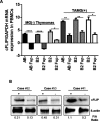cFLIP overexpression in T cells in thymoma-associated myasthenia gravis
- PMID: 26401511
- PMCID: PMC4574807
- DOI: 10.1002/acn3.210
cFLIP overexpression in T cells in thymoma-associated myasthenia gravis
Abstract
Objective: The capacity of thymomas to generate mature CD4+ effector T cells from immature precursors inside the tumor and export them to the blood is associated with thymoma-associated myasthenia gravis (TAMG). Why TAMG(+) thymomas generate and export more mature CD4+ T cells than MG(-) thymomas is unknown.
Methods: Unfixed thymoma tissue, thymocytes derived thereof, peripheral blood mononuclear cells (PBMCs), T-cell subsets and B cells were analysed using qRT-PCR and western blotting. Survival of PBMCs was measured by MTT assay. FAS-mediated apoptosis in PBMCs was quantified by flow cytometry. NF-κB in PBMCs was inhibited by the NF-κB-Inhibitor, EF24 prior to FAS-Ligand (FASLG) treatment for apoptosis induction.
Results: Expression levels of the apoptosis inhibitor cellular FLICE-like inhibitory protein (c-FLIP) in blood T cells and intratumorous thymocytes were higher in TAMG(+) than in MG(-) thymomas and non-neoplastic thymic remnants. Thymocytes and PBMCs of TAMG patients showed nuclear NF-κB accumulation and apoptosis resistance to FASLG stimulation that was sensitive to NF-κB blockade. Thymoma removal reduced cFLIP expression in PBMCs.
Interpretation: We conclude that thymomas induce cFLIP overexpression in thymocytes and their progeny, blood T cells. We suggest that the stronger cFLIP overexpression in TAMG(+) compared to MG(-) thymomas allows for the more efficient generation of mature CD4+ T cells in TAMG(+) thymomas. cFLIP overexpression in thymocytes and exported CD4+ T cells of patients with TAMG might contribute to the pathogenesis of TAMG by impairing central and peripheral T-cell tolerance.
Figures








Similar articles
-
Thymoma Associated Myasthenia Gravis (TAMG): Differential Expression of Functional Pathways in Relation to MG Status in Different Thymoma Histotypes.Front Immunol. 2020 Apr 16;11:664. doi: 10.3389/fimmu.2020.00664. eCollection 2020. Front Immunol. 2020. PMID: 32373124 Free PMC article.
-
Late-onset myasthenia gravis - CTLA4(low) genotype association and low-for-age thymic output of naïve T cells.J Autoimmun. 2014 Aug;52:122-9. doi: 10.1016/j.jaut.2013.12.006. Epub 2013 Dec 24. J Autoimmun. 2014. PMID: 24373506
-
Paraneoplastic myasthenia gravis correlates with generation of mature naive CD4(+) T cells in thymomas.Blood. 2002 Jul 1;100(1):159-66. doi: 10.1182/blood.v100.1.159. Blood. 2002. PMID: 12070022
-
Thymoma related myasthenia gravis in humans and potential animal models.Exp Neurol. 2015 Aug;270:55-65. doi: 10.1016/j.expneurol.2015.02.010. Epub 2015 Feb 18. Exp Neurol. 2015. PMID: 25700911 Review.
-
Thymoma and paraneoplastic myasthenia gravis.Autoimmunity. 2010 Aug;43(5-6):413-27. doi: 10.3109/08916930903555935. Autoimmunity. 2010. PMID: 20380583 Review.
Cited by
-
Functional apoptosis profiling identifies MCL-1 and BCL-xL as prognostic markers and therapeutic targets in advanced thymomas and thymic carcinomas.BMC Med. 2021 Nov 16;19(1):300. doi: 10.1186/s12916-021-02158-3. BMC Med. 2021. PMID: 34781947 Free PMC article.
References
-
- Müller-Hermelink HK, Engel PJ, Harris NL. Tumours of the thymus. In: Travis WD, Brambilla E, Müller-Hermelink HK, Harris CC, editors. Tumours of the lung, thymus, and heart pathology and genetics. Lyon: IARC Press; 2004. pp. 145–151. . In:, eds., et al..
-
- Marchevsky AM, Gupta R, McKenna RJ, et al. Evidence-based pathology and the pathologic evaluation of thymomas: the World Health Organization classification can be simplified into only 3 categories other than thymic carcinoma. Cancer. 2008;112:2780–2788. - PubMed
-
- Gupta R, Marchevsky AM, McKenna RJ, et al. Evidence-based pathology and the pathologic evaluation of thymomas: transcapsular invasion is not a significant prognostic feature. Arch Pathol Lab Med. 2008;132:926–930. - PubMed
-
- Marx A, Pfister F, Schalke B, et al. The different roles of the thymus in the pathogenesis of the various myasthenia gravis subtypes. Autoimmun Rev. 2013;12:875–884. - PubMed
LinkOut - more resources
Full Text Sources
Other Literature Sources
Research Materials
Miscellaneous

